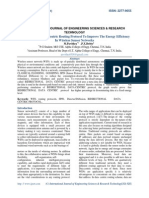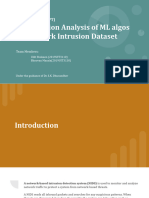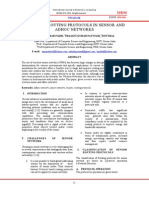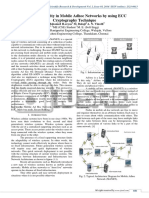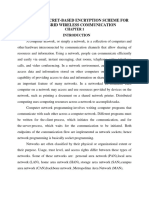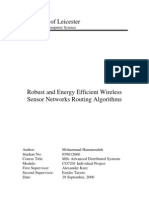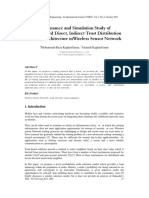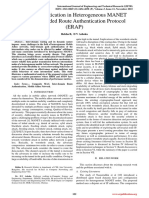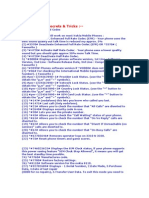Flio Failure Links Into Optimistic Using Diffie Hellmen Key Algorithm
Flio Failure Links Into Optimistic Using Diffie Hellmen Key Algorithm
IJRET: International Journal of Research in Engineering and Technology eISSN: 2319-1163 | pISSN: 2321-7308
_______________________________________________________________________________________
Volume: 03 Special Issue: 07 | May-2014, Available @ http://www.ijret.org 720
FLIO: FAILURE LINKS INTO OPTIMISTIC USING DIFFIE HELLMEN
KEY ALGORITHM
J. Antony Daniel Rex
1
1
M. Phil., Research scholar, PG and Research Department of Computer Science, Government Arts College
(Autonomous), Salem (Tamil Nadu), India
Abstract
In Mobile ad-hoc network (MANET) a node may transfer the data to the destination with the help of the cooperative node. A
change in network topology may degrade the path of current data transfer, and then it causes the link failure. In this kind of
routing, security and key organization are important and complex problem. This research work tries to give a solution for link
failure by using Distributed Time Sequence Routing protocol (DTSR), the DTSR is used to locate the correct relay node and sink
node for data transmission.
Keywords: DSDV, Key Agreement, Link Failure, MANET, etc
--------------------------------------------------------------------***----------------------------------------------------------------------
1. INTRODUCTION
In mobile ad-hoc network, there is no need of any
infrastructure network, Node can be move anywhere. So that
MANET can be defined as an independent mobile node that
communicates over wireless links without any
infrastructure. Here every node at as a router it can transfer
the data to source to distention Router only fixes how to
forward packets to node. There are various routing protocols
are been used to MANET .if the path node have stable link
then the data will reach the distention, at the time of sending
data if the node topology has been change, then link failure
will accrue in MANET. The communication of each node
has to known each other then only the failure will not
accrue, for the intend they need key agreement for each
node, it also give the vulnerable to the node and secure to
the packets.
2. KEY AGREEMENT
In the proposed system Distributed Time Sequence Routing
protocol (DTSR) is used to send the data efficiently and
quickly on the network. DTSR protocol is used to transfer
the data without any modification. Availability parameters
are connectivity and functionality in the network
organization layer. Loss is the fraction of packets lost in
transit from sender to target during a specific time interval,
expressed in percentages. The Proposed system aim is to
improve the network throughput, Network delivery ratio,
and availability and data loss. Consequently, the Diffie-
Hellman algorithm is used with a form of authentication
which uses the certificates to ensure that symmetric keys are
established between nodes. The steering metrics are
evaluated in dissimilar literatures to indicate the significance
and measuring purpose of frequent routing protocols. A
cryptographic key exchange method was developed by
Whitfield Diffie and Martin Hellman in 1976. This method
is called as Diffie-Hellman-Merkle method. Key
distribution is an important aspect of conventional algorithm
and the entire safety is dependent on the distribution of key
using secured channel
Key exchange algorithm is:
Step1: GLOBAL PUBLIC ELEMENTS
Select any prime no.: q Calculate the Primitive
root of q:a such that a<q.
Step2: ASYMMETRIC KEY GENERATION BY USER
A
Select a Random number as private key X
A
where
X
A
<q. calculate the public key
Y
A
where Y
A
= a
X
A
mod q.
Step3: KEY GENERATION BY USER B
Choose an arbitrary number as the private key X
B
where X
B
< q Calculate the public Key Y
B
where
Y
B
= a
X
B
mod q.
Step4: Exchange the values of public key between A and
B
Step5: SYMMETRIC KEY (K) GENERATION BY
USER 'A
K=Y
B
X
A
mod q.
Step 6: SYMMETRIC KEY (K) GENERATION BY USER
'B'
K= Y
A
X
B
mod q.
IJRET: International Journal of Research in Engineering and Technology eISSN: 2319-1163 | pISSN: 2321-7308
_______________________________________________________________________________________
Volume: 03 Special Issue: 07 | May-2014, Available @ http://www.ijret.org 721
3. EXPERIMENTAL RESULT
3.1 Packet Delivery Ratio
Packet Delivery Ratio (PDR) is shown figure 1 and it has
been calculated by dividing the number of packets received
by the destination through the number of packets originated
by the source.
PDR = Total number of data delivered
Total numbers of sending data
Fig 1: Proposed System
4. CONCLUSIONS
Most of the Link failure will be occurs in MANET by
topology change, here this work Present the key distribution
scheme, based on intrusion detection method for using a
data transmission from source to destination on the network.
It based high level security and more energy efficient data
transmission on their network. Transfer the data form source
to destinations within the node coverage area using Diffe
Hellman key algorithm. In this algorithm is used to avoid
the link failure and it also provide the secure to the packet
transfer.
This work has used efficient Symmetric cryptographic
primitives, called key authentication protocol with shared
secret keys between communicating nodes on the ad-hoc
network. It prevents Denial-of-Service attacks and
modification of hop count attacks by malicious node.
In future, work may be conducted to improve the
performance metrics of packet delivery ratio and control
overhead of Secured DSDV by using efficient multi-hop
route cache techniques.
REFERENCES
[1] Key Distributed Cryptography using Key Algorithm
in MANET ISSN (Print) : 2319 2526, Volume-2,
Issue-5, 2013, Rajesh Kumar Dangi, Rachna Singh
Thakur
[2] An Algorithm for Improvement of Link Failure in
Mobile Ad-Hoc Network Vibhor Kumar Goal* and
Rishabh Shrivastava** and Vivek Malik*
International Journal for Science and Emerging ISSN
No. (Online):2250-3641Technologieswith Latest
Trends 10(1): 15-18 (2013)
[3] LSR Protocol Based On Nodes Potentiality in Trust
and Residual Energy for ADHOC NETWORKs,
Shaik Sahil Babu #1 , Arnab Raha #2 , M.K. Naskar
#3 International Journal of Network Security & Its
Applications (IJNSA), Vol.4, No.2, March 2012
[4] A survey on power aware routing protocols in
mobile adhoc networks by Dr.D.Vasumathi,
N.Sainath, U.Moulali, B.Koteshwara Rao July-
august 2012
[5] Identifying Trusted Routing Path in ADHOC
NETWORKs through TARF, Journal of Advanced
Technology in Engineering, Vol. 1, No. 1,
December 2012. pp.37-41.
[6] Design and implementation of a Trust-aware routing
protocol for large ADHOC NETWORKs, Theodore
Zahariadis11 , Helen Leligou, Panagiotis Karkazis 5
, International Journal of Network Security & Its
Applications (IJNSA), Vol.2, No.3, July 2010
[7] Stallings, W., Cryptography and Network security:
Principles and Practices, Fourth Edition, Pearson
Education, 2006.
[8] A Key Management Scheme for Wireless Sensor
Networks Using Deployment Knowledge, published
in Proceedings of the IEEE INFOCOM, March 7-11,
2004, Hong Kong. Pages 586-597.
[9] Chung and U. Roedig. Poster Abstract: DHB-KEY
A Dife-Hellman Key Distribution Protocol for
Wireless SensorNetworks, Adjunct Proceedings of
the 5th IEEE EuropeanWorkshop on Wireless Sensor
Networks (EWSN2008), Bologna,Italy, January
2008.
[10] DHB-KEY: An efficient key distribution scheme
forwireless sensor networks, Infolab21, Lancaster
Univ., Lancaster Mobile Ad Hoc and Sensor
Systems, 2008. MASS 2008. 5th IEEE International
Conference on
BIOGRAPHIE
J. Antony Daniel Rex, M. Phil., Research
Scholar, Govt. Arts College, Salem
636007. I have attended three National level
Workshops, One National level Seminar and
Published one Paper titled as Routing
Protocols in MANET in National level
Conference.
You might also like
- TriPac EVOLUTION Diagnostic Manual 55739-19-OD Rev 0 (08-13)86% (21)TriPac EVOLUTION Diagnostic Manual 55739-19-OD Rev 0 (08-13)341 pages
- A Discovery of Witches Deborah E. Harkness84% (64)A Discovery of Witches Deborah E. Harkness283 pages
- The Hacker Playbook 1 - Practical Guide To Penetration Testing91% (11)The Hacker Playbook 1 - Practical Guide To Penetration Testing308 pages
- CompTIA Network+ Certification Passport, 7th Edition Exam N10 008100% (6)CompTIA Network+ Certification Passport, 7th Edition Exam N10 008449 pages
- Lec. 17 18 Manual Part Programming, Formats. Code and Cycles - SINUMERIK System 810 T100% (1)Lec. 17 18 Manual Part Programming, Formats. Code and Cycles - SINUMERIK System 810 T23 pages
- American Survival Guide, Prepper Survival Field Manual - Spring 2017100% (12)American Survival Guide, Prepper Survival Field Manual - Spring 2017132 pages
- Universal Codes For Cell Phones and Advanced Tricks80% (5)Universal Codes For Cell Phones and Advanced Tricks30 pages
- Cannibalism Blood Drinking High Adept Satanism by Kerth Barker Z Liborgepub100% (5)Cannibalism Blood Drinking High Adept Satanism by Kerth Barker Z Liborgepub194 pages
- Twinkl Omnivore-Carnivore-Or-Herbivore-Venn-Diagram-Sorting-Activity-Sheet - Ver - 3No ratings yetTwinkl Omnivore-Carnivore-Or-Herbivore-Venn-Diagram-Sorting-Activity-Sheet - Ver - 33 pages
- RSI Indicator Trading Strategy, 5 Systems + Back Test Results!100% (9)RSI Indicator Trading Strategy, 5 Systems + Back Test Results!22 pages
- Hierarchical Intrusion Detection System in Cluster Based Wireless Sensor Network Using Multiple Mobile Base StationsNo ratings yetHierarchical Intrusion Detection System in Cluster Based Wireless Sensor Network Using Multiple Mobile Base Stations6 pages
- Secure Data Dissemination Protocol in Wireless Sensor Networks Using Xor Network CodingNo ratings yetSecure Data Dissemination Protocol in Wireless Sensor Networks Using Xor Network Coding5 pages
- Energy-Efficient Secure Data Aggregation Framework (Esdaf) Protocol in Heterogeneous Wireless Sensor NetworksNo ratings yetEnergy-Efficient Secure Data Aggregation Framework (Esdaf) Protocol in Heterogeneous Wireless Sensor Networks10 pages
- Enhancement in Elimination of Security Threads Using Trusted Proactive RoutingNo ratings yetEnhancement in Elimination of Security Threads Using Trusted Proactive Routing7 pages
- New Security Algorithm For Mobile Adhoc Networks Using Zonal Routing ProtocolNo ratings yetNew Security Algorithm For Mobile Adhoc Networks Using Zonal Routing Protocol4 pages
- Mint-Route To Avoid Congestion in Wireless Sensor NetworkNo ratings yetMint-Route To Avoid Congestion in Wireless Sensor Network4 pages
- Data Dissemination Methods in Wireless Sensor Networks: A SurveyNo ratings yetData Dissemination Methods in Wireless Sensor Networks: A Survey5 pages
- Performance Evaluation of LEACH Protocol For Wireless Sensor NetworkNo ratings yetPerformance Evaluation of LEACH Protocol For Wireless Sensor Network5 pages
- Implementing A Cooperative Mac Protocol For Wireless LansNo ratings yetImplementing A Cooperative Mac Protocol For Wireless Lans8 pages
- Dual Step Hybrid Routing Protocol For Network Lifetime Enhancement in WSN-IoT EnvironmentNo ratings yetDual Step Hybrid Routing Protocol For Network Lifetime Enhancement in WSN-IoT Environment9 pages
- Implementation of DYMO Routing Protocol and Its Comparative Performance Analysis With DSR ProtocolNo ratings yetImplementation of DYMO Routing Protocol and Its Comparative Performance Analysis With DSR Protocol9 pages
- An Efficient Routing Protocol For Mobile Ad Hoc Network For Secured Communication and Minimized Power ConsumptionNo ratings yetAn Efficient Routing Protocol For Mobile Ad Hoc Network For Secured Communication and Minimized Power Consumption8 pages
- Paper-13 MANET - Analysis of Routing Stability Under The Random DirectionNo ratings yetPaper-13 MANET - Analysis of Routing Stability Under The Random Direction8 pages
- Data-Centric Routing in A Wireless Sensor Network: Volume 2, Issue 2, March - April 2013No ratings yetData-Centric Routing in A Wireless Sensor Network: Volume 2, Issue 2, March - April 20136 pages
- Paper-13 MANET - Analysis of Routing Stability Under The Random DirectionNo ratings yetPaper-13 MANET - Analysis of Routing Stability Under The Random Direction8 pages
- An Efficient Routing Protocol For Mobile Ad Hoc Network For Secured Communication and Minimized Power ConsumptionNo ratings yetAn Efficient Routing Protocol For Mobile Ad Hoc Network For Secured Communication and Minimized Power Consumption8 pages
- Dynamic Routing For Data Integrity and Delay Differentiated Services in Wireless Sensor NetworksNo ratings yetDynamic Routing For Data Integrity and Delay Differentiated Services in Wireless Sensor Networks4 pages
- An Efficient Data-Centric Routing Approach For Wireless Sensor Networks Using EdrinaNo ratings yetAn Efficient Data-Centric Routing Approach For Wireless Sensor Networks Using Edrina7 pages
- Trust Worthy Architecture Implementation For Mobile Ad Hoc NetworksNo ratings yetTrust Worthy Architecture Implementation For Mobile Ad Hoc Networks9 pages
- A Min-Max Based Approach For Reliable Routing in Congested NetworkNo ratings yetA Min-Max Based Approach For Reliable Routing in Congested Network5 pages
- Analysis Performance of Different Routing Protocols For MANETs Using NS2 SimulatorNo ratings yetAnalysis Performance of Different Routing Protocols For MANETs Using NS2 Simulator9 pages
- Secure Transmission Services in Wireless Networks Using Key TreesNo ratings yetSecure Transmission Services in Wireless Networks Using Key Trees7 pages
- Thesis On Security in Wireless Sensor Networks100% (3)Thesis On Security in Wireless Sensor Networks6 pages
- A Novel Approach For Optimal Network Selection in Heterogeneous Wireless NetworksNo ratings yetA Novel Approach For Optimal Network Selection in Heterogeneous Wireless Networks4 pages
- Performance Evaluation of AODV, DSDV & DSR Routing Protocol in Grid EnvironmentNo ratings yetPerformance Evaluation of AODV, DSDV & DSR Routing Protocol in Grid Environment8 pages
- Paper 5-MDSA Modified Distributed Storage Algorithm For Wireless Sensor NetworksNo ratings yetPaper 5-MDSA Modified Distributed Storage Algorithm For Wireless Sensor Networks5 pages
- Performance Evaluation of Ad-Hoc Network Routing Protocols Using ns2 SimulationNo ratings yetPerformance Evaluation of Ad-Hoc Network Routing Protocols Using ns2 Simulation6 pages
- A Reliable Routing Technique For Wireless Sensor NetworksNo ratings yetA Reliable Routing Technique For Wireless Sensor Networks6 pages
- Enhanced Security in Mobile Adhoc Networks by Using ECC Cryptography TechniqueNo ratings yetEnhanced Security in Mobile Adhoc Networks by Using ECC Cryptography Technique5 pages
- A Review On Manet Routing Protocols and Its VulnerabilitiesNo ratings yetA Review On Manet Routing Protocols and Its Vulnerabilities11 pages
- Ijesrt: Designing Mobility Using Distance Routing Effect AlgorithmNo ratings yetIjesrt: Designing Mobility Using Distance Routing Effect Algorithm9 pages
- Group28@Dissemination Protocol For Large Sensor NetworkNo ratings yetGroup28@Dissemination Protocol For Large Sensor Network8 pages
- A Dynamic Secret-Based Encryption Scheme For Smart Grid Wireless CommunicationNo ratings yetA Dynamic Secret-Based Encryption Scheme For Smart Grid Wireless Communication48 pages
- A Proposal of A Wireless Sensor Network Routing Protocol: Rgonzalez@ldc - Usb.ve Ncardenas@ldc - Usb.veNo ratings yetA Proposal of A Wireless Sensor Network Routing Protocol: Rgonzalez@ldc - Usb.ve Ncardenas@ldc - Usb.ve13 pages
- Network Coding Based Reliable Multi-Path Routing in Wireless Sensor NetworkNo ratings yetNetwork Coding Based Reliable Multi-Path Routing in Wireless Sensor Network8 pages
- A Detailed Survey On Secured and Load Balanced Cooperative Routing Protocols in Wireless Sensor NetworksNo ratings yetA Detailed Survey On Secured and Load Balanced Cooperative Routing Protocols in Wireless Sensor Networks6 pages
- Concealed Data Aggregation With Dynamic Intrusion Detection System To Remove Vulnerabilities in Wireless Sensor NetworksNo ratings yetConcealed Data Aggregation With Dynamic Intrusion Detection System To Remove Vulnerabilities in Wireless Sensor Networks16 pages
- International Journal of Computational Engineering Research (IJCER)No ratings yetInternational Journal of Computational Engineering Research (IJCER)6 pages
- Robust and Energy Efficient Wireless Sensor Networks Routing Algorithms0% (1)Robust and Energy Efficient Wireless Sensor Networks Routing Algorithms73 pages
- Adaptive Association Rule Mining Based Cross Layer Intrusion Detection System For MANETNo ratings yetAdaptive Association Rule Mining Based Cross Layer Intrusion Detection System For MANET14 pages
- Application of Dijkstra'sAlgorithm in Wireless Communication SystemNo ratings yetApplication of Dijkstra'sAlgorithm in Wireless Communication System6 pages
- Performance and Simulation Study of TheProposed Direct, Indirect Trust Distribution Security Architecture in Wireless Sensor NetworkNo ratings yetPerformance and Simulation Study of TheProposed Direct, Indirect Trust Distribution Security Architecture in Wireless Sensor Network21 pages
- Path Authentication in Heterogeneous MANET Using Extended Route Authentication Protocol (ERAP)No ratings yetPath Authentication in Heterogeneous MANET Using Extended Route Authentication Protocol (ERAP)5 pages
- Energy Efficient, Lifetime Improving and Secure Periodic Data Collection Protocol For Wireless Sensor NetworksNo ratings yetEnergy Efficient, Lifetime Improving and Secure Periodic Data Collection Protocol For Wireless Sensor Networks11 pages
- Cluster Based Misbehaviour Detection and Authentication Using Threshold Cryptography in Mobile Ad Hoc NetworksNo ratings yetCluster Based Misbehaviour Detection and Authentication Using Threshold Cryptography in Mobile Ad Hoc Networks15 pages
- Virtual Energy Based Encryption & Keying On Wireless Sensor NetworkNo ratings yetVirtual Energy Based Encryption & Keying On Wireless Sensor Network10 pages
- Improving Performance With Security Mechanism For Wireless Multi-Hop Relay NetworkNo ratings yetImproving Performance With Security Mechanism For Wireless Multi-Hop Relay Network6 pages
- Ham Radio For The New Ham What To Do The Minute You Get Your Amateur Radio License - Stan Merrill50% (2)Ham Radio For The New Ham What To Do The Minute You Get Your Amateur Radio License - Stan Merrill137 pages
- Ham Radio An Easy Guide For Beginners - Steve Markelo100% (4)Ham Radio An Easy Guide For Beginners - Steve Markelo10 pages
- GMC S15 Workshop Manual (S15-T15 Jimmy 4WD V6-4.3L VIN W (1996-1999) )No ratings yetGMC S15 Workshop Manual (S15-T15 Jimmy 4WD V6-4.3L VIN W (1996-1999) )18,212 pages
- Domain Name System Explained Guide. DNS Guide100% (1)Domain Name System Explained Guide. DNS Guide26 pages
- MS Undercroft Hollowcore Plank Placing Rev A WFNo ratings yetMS Undercroft Hollowcore Plank Placing Rev A WF12 pages
- U4 The Functional Approach. Literal-Direct TranslationNo ratings yetU4 The Functional Approach. Literal-Direct Translation18 pages
- Multivariate Statistical Approaches in Archeology: A Systematic ReviewNo ratings yetMultivariate Statistical Approaches in Archeology: A Systematic Review7 pages
- Excel Engineering College, Komarapalayam: Department of Ece Class Room Furniture Arrangement DetailsNo ratings yetExcel Engineering College, Komarapalayam: Department of Ece Class Room Furniture Arrangement Details4 pages
- Numerical Investigation of Near-Muzzle Blast Levels For Perforated Muzzle Brake Using High Performance ComputingNo ratings yetNumerical Investigation of Near-Muzzle Blast Levels For Perforated Muzzle Brake Using High Performance Computing9 pages
- FEARLESSTEAM_ABDULLAH SIRAJUDDIN SYA'BANA_The Innovation of the Traditional Sawut Lassagna Food Made From Suweg as an Effort to Revitalize Traditional Indonesian Food Which is Increasingly Being Forgotten (1)No ratings yetFEARLESSTEAM_ABDULLAH SIRAJUDDIN SYA'BANA_The Innovation of the Traditional Sawut Lassagna Food Made From Suweg as an Effort to Revitalize Traditional Indonesian Food Which is Increasingly Being Forgotten (1)23 pages



























